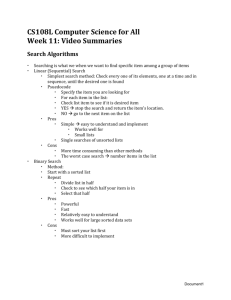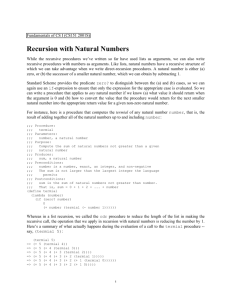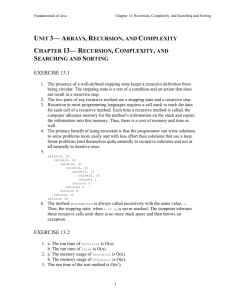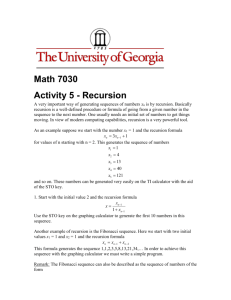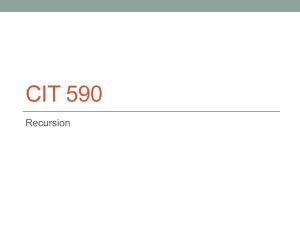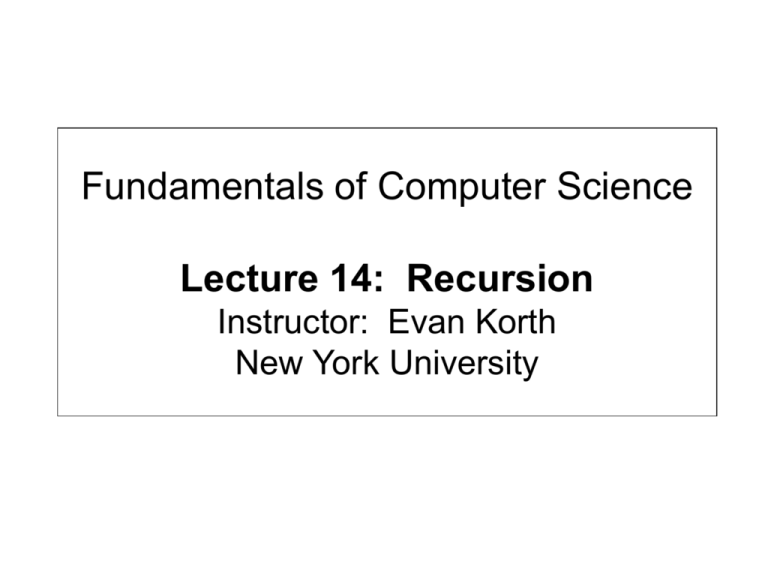
Fundamentals of Computer Science
Lecture 14: Recursion
Instructor: Evan Korth
New York University
Road Map
• Introduction to Recursion
• Recursion Example #1: World’s Simplest
Recursion Program
• Visualizing Recursion
– Using Stacks
• Recursion Example #2
• Computing Factorials
– Iterative Approach
• Computing Factorials
– Recursive Approach
• Reading, Chapter 4, 4.10
Introduction to Recursion
Introduction to Recursion
• So far, we have seen methods that call other
functions.
– For example, the main() method calls the square()
function.
main()
square()
• Recursive Method:
– A recursive method is a method that calls itself.
compute()
Why use Recursive Methods?
• In computer science, some problems are more
easily solved by using recursive functions.
• If you go on to take a computer science algorithms
course, you will see lots of examples of this.
• For example:
– Traversing through a directory or file system.
– Traversing through a tree of search results.
• For today, we will focus on the basic structure of
using recursive methods.
World’s Simplest Recursion
Program
World’s Simplest Recursion Program
public class Recursion
{
public static void main (String args[])
{
count(0);
This program simply counts from 0-2:
System.out.println();
}
012
public static void count (int index)
{
System.out.print(index);
if (index < 2)
count(index+1);
}
}
This is where the recursion occurs.
You can see that the count() function
calls itself.
Visualizing Recursion
• To understand how recursion works, it helps to
visualize what’s going on.
• To help visualize, we will use a common concept
called the Stack.
• A stack basically operates like a container of trays
in a cafeteria. It has only two operations:
– Push: you can push something onto the stack.
– Pop: you can pop something off the top of the stack.
• Let’s see an example stack in action.
Stacks
The diagram below shows a stack over time.
We perform two pushes and one pop.
8
2
2
2
Time: 0
Time 1:
Time 2:
Time 3:
Time 4:
Empty Stack
Push “2”
Push “8”
Pop: Gets 8
Pop: Gets 2
Stacks and Methods
• When you run a program, the computer creates a
stack for you.
• Each time you invoke a method, the method is
placed on top of the stack.
• When the method returns or exits, the method is
popped off the stack.
• The diagram on the next page shows a sample
stack for a simple Java program.
Stacks and Methods
square()
main()
main()
main()
Time: 0
Time 1:
Time 2:
Time 3:
Empty Stack
Push: main()
Push: square() Pop: square()
Time 4:
Pop: main()
returns a value.
returns a value.
method exits.
method exits.
Stacks and Recursion
• Each time a method is called, you push the method
on the stack.
• Each time the method returns or exits, you pop the
method off the stack.
• If a method calls itself recursively, you just push
another copy of the method onto the stack.
• We therefore have a simple way to visualize how
recursion really works.
Back to the Simple Recursion Program
•
Here’s the code again. Now, that we understand stacks, we can
visualize the recursion.
public class Recursion1V0
{
public static void main (String args[])
{
count(0);
System.out.println();
}
public static void count (int index)
{
System.out.print(index);
if (index < 2)
count(index+1);
}
}
Stacks and Recursion in Action
count(2)
count(1)
count(1)
count(0)
count(0)
count(0)
main()
main()
main()
main()
Time: 0
Time 1:
Time 2:
Time 3:
Time 4:
Empty Stack
Push: main()
Push: count(0) Push: count(1) Push: count(2) Pop everything
Inside count(0):
print (index);
0
if (index < 2)
count(index+1);
Inside count(1):
print (index); 1
if (index < 2)
count(index+1);
…
Times 5-8:
Inside count(2):
print (index);
2
if (index < 2)
count(index+1);
This condition now fails!
Hence, recursion stops, and
we proceed to pop all
functions off the stack.
Recursion, Variation 1
What will the following program do?
public class Recursion1V1
{
public static void main (String args[])
{
count(3);
System.out.println();
}
public static void count (int index)
{
System.out.print(index);
if (index < 2)
count(index+1);
}
}
Recursion, Variation 2
What will the following program do?
public class Recursion1V2
{
public static void main (String args[])
{
count(0);
System.out.println();
}
public static void count (int index)
{
if (index < 2)
count(index+1);
System.out.print(index);
}
}
Note that the print statement
has been moved to the end
of the method.
Recursion Example #2
Recursion Example #2
public class Recursion2
{
public static void main (String args[])
{
upAndDown(1);
System.out.println();
}
public static void upAndDown (int n)
Recursion occurs here.
{
System.out.print ("\nLevel: " + n);
if (n < 4)
upAndDown (n+1);
System.out.print ("\nLEVEL: " + n);
}
}
Determining the Output
• Suppose you were given this problem on the final
exam, and your task is to “determine the output.”
• How do you figure out the output?
• Answer: Use Stacks to Help Visualize
Stack Short-Hand
• Rather than draw each stack like we did last time,
you can try using a short-hand notation.
time
stack
output
•
•
•
•
•
•
•
•
•
time 0:
time 1:
time 2:
time 3:
time 4:
time 5:
time 6:
time 7:
time 8:
empty stack
f(1)
f(1), f(2)
f(1), f(2), f(3)
f(1), f(2), f(3), f(4)
f(1), f(2), f(3)
f(1), f(2)
f(1)
empty
Level: 1
Level: 2
Level: 3
Level: 4
LEVEL: 4
LEVEL: 3
LEVEL: 2
LEVEL: 1
Computing Factorials
Factorials
• Computing factorials are a classic problem for
examining recursion.
• A factorial is defined as follows:
n! = n * (n-1) * (n-2) …. * 1;
• For example:
1! = 1 (Base Case)
2! = 2 * 1 = 2
3! = 3 * 2 * 1 = 6
4! = 4 * 3 * 2 * 1 = 24
5! = 5 * 4 * 3 * 2 * 1 = 120
Iterative Approach
import javax.swing.JOptionPane;
public class FindFactorialIterative
{
public static void main (String args[])
{
int answer, n;
String nAsString = JOptionPane.showInputDialog("Enter a number: ");
n = Integer.parseInt (nAsString);
answer = findFactorial (n);
System.out.println ("Answer: " + answer);
System.exit(0);
}
public static int findFactorial (int n)
{
int i, factorial = n;
for (i = n - 1; i >= 1; i--)
factorial = factorial * i;
return factorial;
}
}
This is an iterative solution to finding a factorial.
It’s iterative because we have a simple for loop.
Note that the for loop goes from n-1 to 1.
Factorials
• Computing factorials are a classic problem for
examining recursion.
• A factorial is defined as follows:
n! = n * (n-1) * (n-2) …. * 1;
• For example:
1! = 1 (Base Case)
2! = 2 * 1 = 2
3! = 3 * 2 * 1 = 6
4! = 4 * 3 * 2 * 1 = 24
5! = 5 * 4 * 3 * 2 * 1 = 120
If you study this table closely, you
will start to see a pattern.
Seeing the Pattern
• Seeing the pattern in the factorial example is
difficult at first.
• But, once you see the pattern, you can apply this
pattern to create a recursive solution to the
problem.
• Divide a problem up into:
– What it can do (usually a base case)
– What it cannot do
• What it cannot do resembles original problem
• The function launches a new copy of itself (recursion step) to
solve what it cannot do.
Factorials
• Computing factorials are a classic problem for
examining recursion.
• A factorial is defined as follows:
n! = n * (n-1) * (n-2) …. * 1;
• For example:
1! = 1 (Base Case)
2! = 2 * 1 = 2
3! = 3 * 2 * 1 = 6
4! = 4 * 3 * 2 * 1 = 24
5! = 5 * 4 * 3 * 2 * 1 = 120
If you study this table closely, you
will start to see a pattern.
The pattern is as follows:
You can compute the factorial of
any number (n) by taking n and
multiplying it by the factorial of (n-1).
For example:
5! = 5 * 4!
(which translates to 5! = 5 * 24 = 120)
Recursive Solution
public class FindFactorialRecursive
{
public static void main (String args[])
{
for (int i = 1; i < 10; i++)
System.out.println ( i + "! = " + findFactorial(i));
}
public static int findFactorial (int number)
{
if ( (number == 1) || (number == 0) )
return 1;
Base Case.
else
return (number * findFactorial (number-1));
}
}
Finding the factorial of 3
fact(1)
1
fact(2)
fact(2)
fact(2)
fact(3)
fact(3)
fact(3)
fact(3)
fact(3)
main()
main()
main()
main()
main()
main()
Time 2:
Time 3:
Time 4:
Time 5:
Time 6:
Time 7:
Push: fact(3)
Push: fact(2)
Push: fact(1)
Pop: fact(1)
Pop: fact(2)
Pop: fact(3)
returns 1.
returns 2.
returns 6.
2
Inside findFactorial(3):
Inside findFactorial(2):
Inside findFactorial(1):
if (number <= 1) return 1;
if (number <= 1) return 1;
if (number <= 1) return 1;
else return (3 * factorial (2)); else return (2 * factorial (1));
else return (1 * factorial (0));
6
29
Example Using Recursion: The Fibonacci
Series
• Fibonacci series
– Each number in the series is sum of two previous numbers
• e.g., 0, 1, 1, 2, 3, 5, 8, 13, 21…
fibonacci(0) = 0
fibonacci(1) = 1
fibonacci(n) = fibonacci(n - 1) + fibonacci( n – 2 )
• fibonacci(0) and fibonacci(1) are base cases
– Golden ratio (golden mean)
2003 Prentice Hall, Inc. All rights reserved.
30
import javax.swing.JOptionPane;
public class FibonacciTest
{
public static void main (String args[])
{
long number, fibonacciValue;
String numberAsString;
numberAsString = JOptionPane.showInputDialog("What Fib value do you want?");
number = Long.parseLong( numberAsString );
fibonacciValue = fibonacci( number );
System.out.println (fibonacciValue);
System.exit (0);
}
// recursive declaration of method fibonacci
public static long fibonacci( long n )
{
if ( n == 0 || n == 1 )
return n;
else
return fibonacci( n - 1 ) + fibonacci( n - 2 );
} // end method fibonacci
} // end class FibonacciTest
2003 Prentice Hall, Inc. All rights reserved.
31
Recursion vs. Iteration
• Iteration
–
–
–
–
Uses repetition structures (for, while or do…while)
Repetition through explicitly use of repetition structure
Terminates when loop-continuation condition fails
Controls repetition by using a counter
• Recursion
–
–
–
–
Uses selection structures (if, if…else or switch)
Repetition through repeated method calls
Terminates when base case is satisfied
Controls repetition by dividing problem into simpler one
2003 Prentice Hall, Inc. All rights reserved.
32
Recursion vs. Iteration (cont.)
• Recursion
–
–
–
–
More overhead than iteration
More memory intensive than iteration
Can also be solved iteratively
Often can be implemented with only a few lines of code
2003 Prentice Hall, Inc. All rights reserved.




